Microscanner
A microscanner (or micro-scanning mirror) is a micro-opto-electromechanical system (MOEMS) in the category of micro-mirror actuators for dynamic light modulation. Depending upon the type of microscanner the modulatory movement of a single mirror can be either translatory or rotational, on one or two axes. In the first case, a phase shifting effect takes place. In the second case, the incident light wave is deflected.
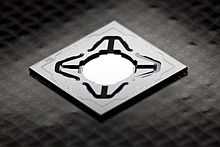
Therefore, they have to be differentiated from spatial light modulators, other micro-mirror actuators which need a matrix of individually addressable mirrors for their mode of operation. If a single array mirror already fulfils the desired modulation but is operated in parallel with other array mirrors in order to increase the light yield, then the term microscanner array is used.
Characteristics
Common chip dimensions are 4 mm × 5 mm for mirror diameters between 1 and 3 mm.[1] However larger mirror apertures with side measurements of up to approx. 10 mm × 3 mm can also be produced.[2] The scan frequencies depend upon the design and mirror size and range between 0.1 and 50 kHz. The deflection movement is either resonant or quasi-static.[3] With microscanners that are capable of tilting movement, light can be directed over a projection plane.
Many applications requires that a surface is addressed instead of only a single line. For double resonant operation, which results in sinusoidal scan motion, a Lissajous pattern is written. Mechanical deflection angles of such micro scanning devices reach up to ±30°.[4] With translational (piston type) microscanners a mechanical stroke of up to approx. ±500 µm can be attained.[5] This configuration is energy efficient, but requires complicated control electronics. For high end display applications the common choice is raster scanning, where a resonant scanner (for the longer display dimension) is paired with quasi-static scanner (for the shorter dimension).[3]
Drive principles
The required drive forces for the mirror movement can be provided by various physical principles. In practice, the relevant principles for driving such a mirror are the electromagnetic, electrostatic, thermo-electric and piezo-electric effects.[3] Because the physical principles differ in their advantages and disadvantages, a suitable driving principle should be chosen according to the application. Specifically, the mechanical solutions required for resonant and quasi-static scanning, respectively, are very different from each other. Thermo-electric actuators are not applicable for high frequency resonant scanners, but the other three principles can be applied to the full spectrum of applications.
For resonant scanners one often employed configuration is the indirect drive. In an indirect drive a small motion in a larger mass is coupled to a large motion in a smaller mass (the mirror) through mechanical amplification at a favorable mode shape. This is in contrast to the more common direct drive, where the actuator mechanism moves the mirror directly. Indirect drives have been implemented for electromagnetic,[6] electrostatic,[7] as well as piezo-electric actuators.[8] [9] There is no general answer to the question if the direct or indirect drive is more efficient, but judging by the performance of existing scanners the indirect drive appears to have the largest impact for piezo-electric scanners.[3]
Electrostatic actuators offer high power similar to electromagnetic drives. In contrast to an electromagnetic drive, the resulting drive force between the drive structures cannot be reversed in polarity. For the realization of quasi-static components with positive and negative effective direction, two drives with positive and negative polarity are required.[10] As a rule of thumb, vertical comb drives are utilized here. Nevertheless the highly non-linear drive characteristics in some parts of the deflection area can be hindering for controlling the mirror properly. For that reason many highly developed microscanners today utilize a resonant mode of operation, where an Eigenmode is activated. Resonant operation is most energy efficient. For beam positioning and applications which are to be static-actuated or linearized-scanned, quasi-static drives are required and therefore of great interest.
Magnetic actuators offer very good linearity of the tilt angle versus the applied signal amplitude, both in static and dynamic operation. The working principle is that a metallic coil is placed on the moving MEMS mirror itself and as the mirror is placed in a magnetic field, the alternative current flowing in the coil generate Lorentz force that tilts the mirror. Magnetic actuation can either be used for actuating 1D or 2D MEMS mirrors. Another characteristics of the magnetically actuated MEMS mirror is the fact the low voltage is required (below 5V) making this actuation compatible with standard CMOS voltage. An advantage of such actuation type is that MEMS behavior does not present hysteresis, as opposed to electrostatic actuated MEMS mirrors, that make it very simple to control. Power consumption of magnetically actuated MEMS mirror can be as low as 0.04 mW.[11]
Thermoelectric drives produce high driving forces, but they present a few technical drawbacks inherent to their fundamental principle. The actuator has to be thermally well insulated from the environment, as well as being pre-heated in order to prevent thermal drift due to environmental influences. That is why the necessary heat output and power consumption for a thermal bimorph actuator is relatively high. One further disadvantage is the comparably low displacement which needs to be leveraged to reach usable mechanical deflections. Also thermal actuators are not suitable for high frequency operation due to significant low pass behaviour.
Piezo-electrical drives produce high force, but as with electro-thermal actuators the stroke length is short. Piezo-electrical drives are, however, less susceptible to thermal environmental influences and can also transmit high-frequency drive signals well. To achieve the desired angle some mechanism utilizing mechanical amplification will be required for most applications. This has proven to be difficult for quasi-static scanners, although there are promising approaches in the literature using long meandering flexures for deflection amplification.[12][13] For resonant rotational scanners, on the other hand, scanners using piezo-electric actuation combined with an indirect drive are the highest performer in terms of scan angle and working frequency.[8][14][9] However, the technology is newer than electro-static and electro-magnetic drives and remains to be implemented in commercial products.[3]
Fields of Application
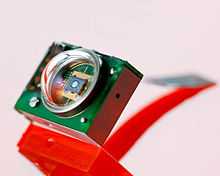 LDC module with 1D microscanner and integrated optical position sensor on the back side |
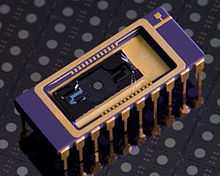 An electrostatic 2D microscanner in a DIL20 casing |
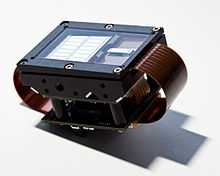 MEMS scanner module for 3D distance measurement (LIDAR) with a single sending mirror (mirror dimensions approx. (9.5 × 2.5 mm)) and a synchronized microscanner array (2 × 7) as receiver unit. |
Applications for tilting microscanners are numerous and include:
- Projection displays[3][6][15]
- Image recording, e.g. for technical and medical endoscopes[4]
- Bar code scanning[16]
- Spectroscopy
- Laser marking and material processing
- Object measurement / triangulation[2]
- 3D cameras
- Object recognition
- 1D and 2D light grid
- Confocal microscopy / OCT
- Fluorescence microscopy
- Laser wavelength modulation
Some of the applications for piston type microscanners are:
- Fourier transform infrared spectrometer
- Confocal microscopy
- Focus variation
Manufacture
 Wafer with resonant microscanners, ready-processed with the Fraunhofer AME75 process (based on blank BSOI wafers), before dicing the devices. |
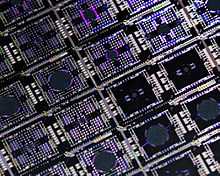 Detail of a wafer with VarioS® microscanners, developed and produced based on a modular fabrication system at Fraunhofer IPMS. |
Microscanners are usually manufactured with surface or bulk micromechanic processes. As a rule, silicon or BSOI (bonded silicon on insulator) are used.
Advantages and disadvantages of microscanners
The advantages of microscanners compared to macroscopic light modulators such as galvanometer scanners are based upon their small size, low weight and minimum power consumption. Further advantages arise along with the integration possibilities of position sensor technology[17] and electronics in the component. Microscanners are also extremely resistant to environmental influences. For example, the microscanners developed at Fraunhofer IPMS have a shock resistance of at least 2500 g. Under the condition that they are sealed free from dust and humidity, they are maintenance-free and operate at temperatures between -20 °C and +80 °C.
Some of the disadvantages due to the manufacturing process are high costs for single devices and long delivery times. In order to address these problems, scientists at Fraunhofer IPMS provide a platform technology – a MEMS modular system called VarioS® – which reduces this problem to a minimum.
References
- ↑ VarioS®Mikroscanner Construction Kit. Fraunhofer Institute for Photonic Microsystems IPMS (Product Description).
- ↑ 2.0 2.1 Sandner, T.; Grasshoff, T.; Wildenhain, M.; Schenk, H. (2010). "Synchronized micro scanner array for large aperture receiver optics of LIDAR systems". Proc. SPIE. 7594 – MOEMS and Miniaturized Systems IX: 75940C. doi:10.1117/12.844923.
- ↑ 3.0 3.1 3.2 3.3 3.4 3.5 Holmstrom, S.T.S.; Baran, U.; Urey, H. (2014). "MEMS Laser Scanners: A Review". Journal of Microelectromechanical System 23 (2): 259–275. doi:10.1109/JMEMS.2013.2295470. Retrieved 2015-02-04.
- ↑ 4.0 4.1 Drabe, C.; James, R.; Schenk, H.; Sandner, T. (2010). "MEMS-Devices for Laser Camera Systems for Endoscopic Applications". Proc. SPIE. 7594 – MOEMS and Miniaturized Systems IX: 759404. doi:10.1117/12.846855.
- ↑ Sandner, T.; Grasshoff, T.; Schenk, H.; Kenda, A. (2011). "Out-Of-Plane Translatory MEMS actuator with extraordinary large stroke for optical path length modulation". Proc. SPIE. 7930 – MOEMS and Miniaturized Systems X: 79300I. doi:10.1117/12.879069.
- ↑ 6.0 6.1 Yalcinkaya, A.D.; Urey, H.; Brown, D.; Montague, T.; Sprague, R. (2006). "Two-Axis Electromagnetic Microscanner for High Resolution Displays". Journal of Microelectromechanical Systems 15 (4): 786–794. doi:10.1109/JMEMS.2006.879380.
- ↑ Arslan, A.; Brown, D.; Davis, W.O.; Holmstrom, S.; Gokce, S.K.; Urey, H. (2010). "Comb-Actuated Resonant Torsional Microscanner With Mechanical Amplification". Journal of Microelectromechanical System 19 (4): 936–943. doi:10.1109/JMEMS.2010.2048095.
- ↑ 8.0 8.1 Baran, U.; Brown, D.; Holmstrom, S.; Balma, D.; Davis, W.O.; Muralt, P.; Urey, H. (2012). "Resonant PZT MEMS Scanner for High-resolution Displays". Journal of Microelectromechanical System 21 (6): 1303–1310. doi:10.1109/JMEMS.2012.2209405.
- ↑ 9.0 9.1 Gu-Stoppel, S.; Janes, J.; Kaden, D.; Quenzer, H.; Hofmann, U.; Benecke, W. (2013). Piezoelectric resonant micromirror with high frequency and large deflection applying mechanical leverage amplification. Proc. SPIE Micromachining and Microfabrication Process Technology XVIII. San Francisco, CA, USA. pp. 86120I–1–86120I–8. doi:10.1117/12.2001620.
- ↑ D. Jung, T. Sandner, D. Kallweit, T. Grasshoff, H. Schenk (2012), "Vertical comb drive microscanners for beam steering, linear scanning and laser projection applications" (in German), MOEMS and Miniaturized Systems XI: pp. 82520U-1-10
- ↑ http://www.lemoptix.com/technology/products/lscanmicromirror
- ↑ Tani, M.; Akamatsu, M.; Yasuda, Y.; Toshiyoshi, H. (2007). A two Axis Piezoelectric Tilting Micromirror with a Newly Developed PZTmeandering Actuator. Proc. IEEE 20th Int. Conf. MEMS. Kobe, Japan. pp. 699–702. doi:10.1109/MEMSYS.2007.4432994.
- ↑ Kobayashi, T.; Maeda, R.; Itoh, T. (2009). "Low Speed Piezoelectric Optical Microscanner Actuated by Piezoelectric Microcantilevers Using LaNiO3 Buffered Pb(Zr, Ti)O3 Thin Film". Smart Materials and Structures 18 (6): 065008–1–065008–6. doi:10.1109/JMEMS.2012.2209405.
- ↑ Baran, U.; Holmstrom, S.; Brown, D.; Davis, W.O.; Cakmak, O.; Urey, H. (2014). Resonant PZT MEMS Scanners with Integrated Angle Sensors. 2014 International Conference on Optical MEMS and Nanophotonics (OMN). Journal of Microelectromechanical System (Glascow, Scotland): 99 – 100. doi:10.1109/OMN.2014.6924612.
- ↑ Scholles, Michael; Bräuer, Andreas; Frommhagen, Klaus; Gerwig, Christian; Lakner, Hubert; Schenk, Harald; Schwarzenberg, Markus (2008). "Ultracompact laser projection systems based on two-dimensional resonant microscanning mirrors". Journal of Micro/Nanolithography, MEMS and MOEMS 7 (2): 021001. doi:10.1117/1.2911643.
- ↑ Wolter, A.; Schenk, H.; Gaumont, E.; Lakner, H. (2004). "MEMS microscanning mirror for barcode reading: from development to production". Proc. SPIE. 5348 – MOEMS Display and Imaging Systems II: 32–39. doi:10.1117/12.530795.
- ↑ Grahmann, J.; Grasshoff, T.; Conrad, H.; Sandner, T.; Schenk, H. (2011). "Integrated piezoresistive position detection for electrostatic driven micro scanning mirrors". Proc. SPIE. 7930 – MOEMS and Miniaturized Systems X: 79300V. doi:10.1117/12.874979.
External links
- MEMS Scanners. Fraunhofer Institute for Photonic Microsystems
- ARI MEMS Micromirror Demonstration Devices. Adriatic Research Institute
- Getting Started with Analog Mirrors. Texas Instruments (Product Page)
- Magnetic MEMS micromirrors. Lemoptix (Technology description Page)